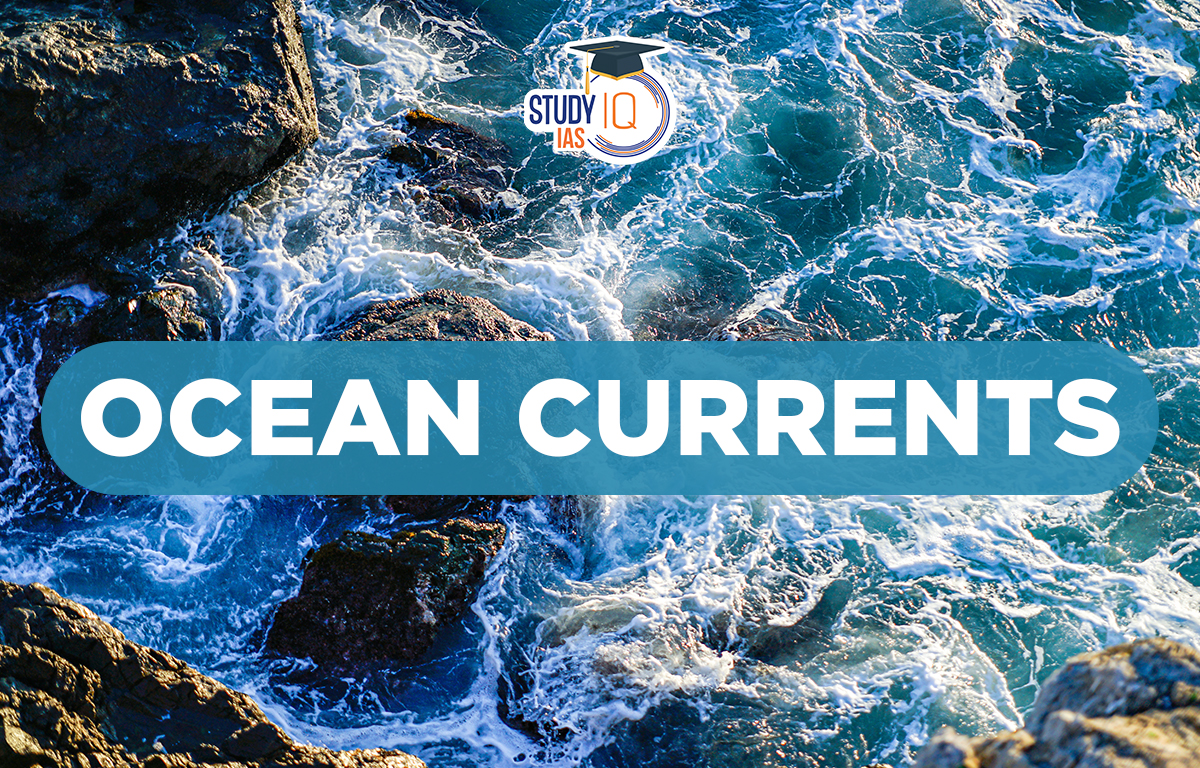Table of Contents
Ocean Currents
Ocean currents are the continuous movement of seawater caused by gravity, wind, and water density. Water moves in two ways:
- Horizontally: Horizontal movements are called currents,
- Vertically: Vertical changes are called upwellings or downwellings. These currents help transfer heat, affect biodiversity, and influence Earth’s climate.
Ocean currents are classified as warm or cold based on where they flow. Warm currents move toward the poles, bringing warm water from lower latitudes to higher ones. Cold currents flow from the high latitudes down to the tropics.
Ocean Currents Types
Ocean Currents are of the following types:
Based on Depth
Based on the depth, the ocean currents are classified as surface currents and deep water currents:
- Surface currents are those currents that circulate to a depth of 400m from the surface; they roughly constitute about 10 percent of all the water in the ocean.
- Deepwater currents are caused due to changes in density and under the influence of gravity. They make up the other 90 percent of the ocean water.
The changes in the temperatures and salinity determine the density, which causes the vertical movement of water. Deep waters sink into deep ocean basins at high latitudes when temperatures are cold enough to cause the density to rise.
Based on Temperature
Based on temperature, ocean currents are classified as cold currents and warm currents:
- Cold currents transport cold water from high latitudes to low latitudes, bringing cold water into warm water areas. These currents are most commonly seen on the west coasts of continents at low and middle latitudes (in both hemispheres) and on the east coast at higher latitudes in the Northern Hemisphere.
- Warm currents transport warm water from low to high latitudes and are most commonly seen on the east coasts of continents in the low and intermediate latitudes (true in both hemispheres). They can be found on the west coasts of continents at high latitudes in the northern hemisphere.
Ocean Currents Influence
1. Influence of Insolation
When the sun heats the water it gets bigger. Because of this ocean water at the equator is about 8 cm higher than in the middle areas. This creates a slight slope, and water flows from the higher part to the lower part.
2. Influence of Gravity
Gravity pulls the water down, which causes it to collect and create differences in height.
3. Influence of Temperature
Temperature differences between ocean water at the equator and the poles affect currents. Warm water is lighter and rises, while cold water is heavier and sinks. Warm water moves slowly along the surface toward the poles, while cold water moves along the sea bottom toward the equator.
4. Influence of Salinity
Based on the temperature, geographical area, the inflow of fresh water, etc., the salinity of ocean water varies from place to place. Waters of high salinity are denser than the waters of low salinity. Hence, high salinity waters sink and flow at the bottom towards low salinity waters. On the other hand, ocean waters of low salinity flow on the surface of ocean waters and move towards high salinity waters. For Example, in the partially enclosed Mediterranean Sea, there is a great difference in salinity between the waters of the open Atlantic Ocean and those of the Mediterranean Sea. The less saline water from the Atlantic Ocean flows into the Mediterranean Sea. However, this inflow is compensated by denser water that flows from the bottom of the Mediterranean to the Atlantic Ocean.
Influence Due to the Earth’s Rotation
Coriolis Force:
The Earth’s rotation causes moving objects, like ocean currents, to turn right in the northern hemisphere (clockwise) and left in the southern hemisphere (counter-clockwise).
Geographical Influence:
Land masses can block and change the direction of ocean currents. For example, the Peruvian Current is created when the West Wind Drift is pushed north by the tip of southern Chile.
Influence of the Trade Winds
Trade Winds:
These winds blow between the equator and the tropics, pushing warm water westwards and polewards. For example, the North-East Trade Winds warm the southern and eastern coasts of the U.S. by moving the North Equatorial Current and the Florida Current.
Westerlies:
These winds blow in temperate regions, moving water northeast in the northern hemisphere. They drive the warm Gulf Stream to Europe’s western coast as the North Atlantic Drift. However, they are less reliable than the Trade Winds.
Planetary Winds:
The most significant impact on ocean currents comes from planetary winds. In the North Indian Ocean, monsoon winds change the direction of currents, blowing from the northeast in winter and the southwest in summer.
Ocean Currents Atlantic Ocean
The North and South Equatorial Currents near the equator move from east to west because of steady Trade Winds. In northeast Brazil, the South Equatorial Current splits into two parts: the Cayenne Current, which goes down the coast of Guiana, and the Brazilian Current, which flows south along Brazil’s east coast.
The Cayenne Current connects with the North Equatorial Current in the North Atlantic Ocean and flows northwest into the Caribbean Sea. The Florida Current comes from the strait between Florida and Cuba and is part of the water that enters the Gulf of Mexico. Most of this equatorial water moves northeast past the Antilles and eventually joins the Gulf Stream off the U.S. coast. The Gulf Stream is a powerful current, about 35 to 100 miles wide, 2,000 feet deep, and flowing at about three miles per hour. It travels along the American coast and then gets pushed east by the Westerlies and the Earth’s rotation. As it reaches Europe, it’s called the North Atlantic Drift, carrying warm equatorial water to European shores. This current splits into three paths: one goes to Britain, another heads north to the Arctic, and the last flows south along the Iberian coast.
Studies show that about two-thirds of the water that the Gulf Stream sends to the Arctic returns each year as cold, dense Polar water, moving south at the ocean’s bottom. The Canaries Current, which flows south, eventually joins the North Equatorial Current, completing a clockwise flow in the North Atlantic. In the middle of this circular current system, there’s a calm area with little current called the Sargasso Sea, which is filled with drifting seaweed.
Cold currents also come into the North Atlantic from the Arctic. Arctic winds push these chilly waters south. The Irminger Current, which flows between Iceland and Greenland, cools the warm North Atlantic Drift. Meanwhile, the cold Labrador Current moves southeast from between West Greenland and Baffin Island until it meets the warm Gulf Stream near Newfoundland.
The South Atlantic Ocean has a similar current system, but it moves in the opposite direction (anti-clockwise). The calm seas in the mid-South Atlantic don’t gather as much seaweed. At Cape Sao Roque, the South Equatorial Current splits into two branches, with one going south as the warm Brazilian Current. The prevailing Westerlies and the Earth’s rotation push this current eastward, where it merges with the cold West Wind Drift to become the South Atlantic Current. When it reaches Africa’s west coast, it turns north as the cold Benguela Current, which carries chilly polar waters to warmer areas. The Benguela Current flows north-westward due to the Southeast Trade Winds and eventually joins the South Equatorial Current, completing the circulation in the South Atlantic. There is also an east-flowing Equatorial Counter Current between the North and South Equatorial Currents.
The circulation pattern in the Pacific Ocean is similar to that of the Atlantic, but it’s larger and more open, leading to some differences.
Ocean Currents Indian Ocean
The South Indian Ocean’s currents form a loop similar to those in the Atlantic and Pacific Oceans. The Equatorial Current merges with the West Wind Drift, which flows east, then turns north as the West Australian Current and finally heads south past Madagascar as the Agulhas or Mozambique Current. In the North Indian Ocean, monsoon winds cause the currents to reverse direction between summer and winter. From June to October, during the South-West Monsoon, the currents flow south-west as the South-West Monsoon Drift.
This is reversed during the winter, commencing in December, when the North-East Monsoon Drift blows the currents from the northeast. The North Indian Ocean currents are the most striking example of the dominance of winds over ocean current circulation.
Cold Ocean Currents List
Here is the List of Cold Ocean Currents
| Cold Ocean Current | Region | Important or Additional Facts |
| Humboldt or Peruvian Current | South Pacific Ocean |
|
| Kurile or Oyashio Current | North Pacific Ocean |
|
| California Current | Pacific Ocean |
|
| Antarctic Circumpolar Current | Southern Ocean |
|
| Labrador Current | North Atlantic Ocean |
|
| Canary Current | North Atlantic Ocean |
|
| Eastern Greenland Current | Arctic Ocean & North Atlantic Ocean |
|
| Benguela Current | South Atlantic Ocean |
|
| Falkland Current | South Atlantic Ocean |
|
| Northeast Monsoon Current | North Indian Ocean |
|
| Somali Current | West Indian Ocean |
|
| Western Australian Current | Southern Ocean & South Indian Ocean |
|
| South Indian Ocean Current | South Indian Ocean |
|
Warm Ocean Currents List
Here is the list of Warm Ocean Currents
| List of Warm Warm Ocean Current | Region | Important or Additional Facts |
| North Equatorial Current | Pacific Ocean & Atlantic Ocean |
|
| Kuroshio Current | Pacific Ocean |
|
| North Pacific Current | Pacific Ocean |
|
| Alaskan Current | North Pacific Ocean |
|
| Equatorial Counter Current | Atlantic Ocean, Pacific Ocean, and the Indian Ocean |
|
| El Nino Current | Central & East-Central Equatorial Pacific |
|
| Tsushima Current | Sea of Japan |
|
| South Equatorial Current | Atlantic Ocean, Pacific Ocean, and the Indian Ocean |
|
| East Australian Current | South-Western Pacific Ocean |
|
| Florida Current | South Atlantic Ocean & Caribbean Sea |
|
| Gulf Stream | North Atlantic Ocean |
|
| Norwegian Current | North Sea (Atlantic Ocean) & Barents Sea (Arctic Ocean) |
|
| Antilles Current | North Atlantic Ocean |
|
| Irminger Current | North Atlantic Ocean |
|
| Brazilian Current | South Atlantic Ocean |
|
| Mozambique Current | Indian Ocean |
|
| Agulhas Current | South-West Indian Ocean |
|
| Southwest Monsoon Current | Indian Ocean |
|
Ocean Currents UPSC
A continuous general movement of ocean water in a specified direction is called an ocean current.
Ocean currents are the directional movement of seawater that is continuous and predictable. It is a massive movement of ocean water caused and influenced by a number of forces. They are similar to river flows in oceans. A solid understanding of this subject is required to help individuals pass competitive exams. On that note, we have covered this topic exclusively for students preparing for the UPSC and IAS exams.


 Story of Meera Bai and Her Devotion For ...
Story of Meera Bai and Her Devotion For ...
 Desert Climate, Distribution, Climatic C...
Desert Climate, Distribution, Climatic C...
 Deserts of India Map, Features of Thar D...
Deserts of India Map, Features of Thar D...





















